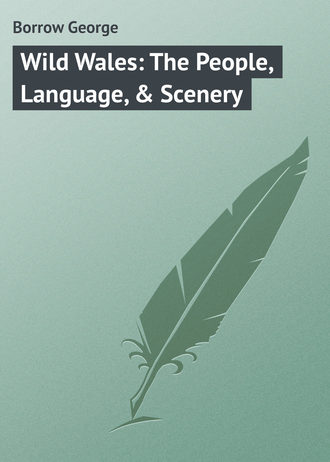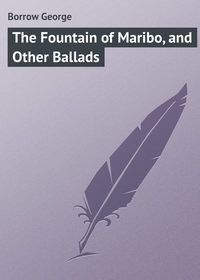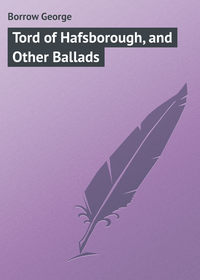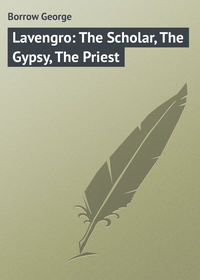 полная версия
полная версияWild Wales: The People, Language, & Scenery
“Who holds the estate at present?” said I.
“Why, a great gentleman from Lancashire, your honour, who bought it when the Duke died; but he doesn’t take the same pleasure in it which the Duke did, nor spend so much money about it, the consequence being that everything looks very different from what it looked in the Duke’s time. The inn at the Devil’s Bridge and the grounds look very different from what they looked in the Duke’s time, for you must know that the inn and the grounds form part of the Hafod estate, and are hired from the proprietor.”
By this time we had arrived at a small village, with a toll-bar and a small church or chapel at some little distance from the road, which here made a turn nearly full south. The road was very good, but the country was wild and rugged; there was a deep vale on the right, at the bottom of which rolled the Rheidol in its cleft, rising beyond which were steep, naked hills.
“This village,” said my companion, “is called Ysbytty Cynfyn. Down on the right, past the church, is a strange bridge across the Rheidol, which runs there through a horrid kind of a place. The bridge is called Pont yr Offeiriad, or the Parson’s Bridge, because in the old time the clergyman passed over it every Sunday to do duty in the church here.”
“Why is this place called Ysbytty Cynfyn?” said I, “which means the hospital of the first boundary; is there a hospital of the second boundary near here?”
“I can’t say anything about boundaries, your honour; all I know is, that there is another Spytty farther on beyond Hafod called Ysbytty Ystwyth, or the ’Spytty upon the Ystwyth. But to return to the matter of the Minister’s Bridge: I would counsel your honour to go and see that bridge before you leave these parts. A vast number of gentry go to see it in the summer time. It was the bridge which the landlord was mentioning last night, though it scarcely belongs to his district, being quite as near the Devil’s Bridge inn, as it is to his own, your honour.”
We went on discoursing for about half-a-mile farther, when, stopping by a road which branched off to the hills on the left, my companion said, “I must now wish your honour good day, being obliged to go a little way up here to a mining work on a small bit of business; my son, however, and his dog Joe will show your honour the way to the Devil’s Bridge, as they are bound to a place a little way past it. I have now but one word to say, which is, that should ever your honour please to visit me at my mine, your honour shall receive every facility for inspecting the works, and moreover have a bellyfull of drink and victuals from Jock Greaves, miner from the county of Durham.”
I shook the honest fellow by the hand and went on in company with the lad John and his dog as far as the Devil’s Bridge. John was a highly intelligent lad, spoke Welsh and English fluently, could read, as he told me, both languages, and had some acquaintance with the writings of Twm o’r Nant, as he showed by repeating the following lines of the carter poet, certainly not the worst which he ever wrote: —
“Twm o’r Nant mae cant a’m galwTomas Edwards yw fy enw.Tom O Nant is a nickname I’ve got,My name’s Thomas Edwards, I wot.”CHAPTER LXXXIV
The Hospice – The Two Rivers – The Devil’s Bridge – Pleasant Recollections.
I arrived at the Devil’s Bridge at about eleven o’clock of a fine but cold day, and took up my quarters at the inn, of which I was the sole guest during the whole time that I continued there, for the inn, standing in a lone, wild district, has very few guests except in summer, when it is thronged with tourists, who avail themselves of that genial season to view the wonders of Wales, of which the region close by is considered amongst the principal.
The inn, or rather hospice, for the sounding name of hospice is more applicable to it than the common one of inn, was built at a great expense by the late Duke of Newcastle. It is an immense lofty cottage with projecting eaves, and has a fine window to the east which enlightens a stately staircase and a noble gallery. It fronts the north and stands in the midst of one of the most remarkable localities in the world, of which it would require a far more vigorous pen than mine to convey an adequate idea.
Far to the west is a tall, strange-looking hill, the top of which bears no slight resemblance to that of a battlemented castle. This hill, which is believed to have been in ancient times a stronghold of the Britons, bears the name of Bryn y Castell or the hill of the castle. To the north-west are russet hills, to the east two brown paps, whilst to the south is a high, swelling mountain. To the north and just below the hospice is a profound hollow with all the appearance of the crater of an extinct volcano; at the bottom of this hollow the waters of two rivers unite; those of the Rheidol from the north, and those of the Afon y Mynach, or the Monks’ River, from the south-east. The Rheidol falling over a rocky precipice at the northern side of the hollow forms a cataract very pleasant to look upon from the middle upper window of the inn. Those of the Mynach which pass under the celebrated Devil’s Bridge are not visible, though they generally make themselves heard. The waters of both, after uniting, flow away through a romantic glen towards the west. The sides of the hollow, and indeed of most of the ravines in the neighbourhood, which are numerous, are beautifully clad with wood.
Penetrate now into the hollow above which the hospice stands. You descend by successive flights of steps, some of which are very slippery and insecure. On your right is the Monks’ River, roaring down its dingle in five successive falls, to join its brother the Rheidol. Each of the falls has its own peculiar basin, one or two of which are said to be of awful depth. The length which these falls with their basins occupy is about five hundred feet. On the side of the basin of the last but one is the cave, or the site of the cave, said to have been occupied in old times by the Wicked Children, the mysterious Plant de Bat, two brothers and a sister, robbers and murderers. At present it is nearly open on every side, having, it is said, been destroyed to prevent its being the haunt of other evil people: there is a tradition in the country that the fall at one time tumbled over its mouth. This tradition, however, is evidently without foundation, as from the nature of the ground the river could never have run but in its present channel. Of all the falls the fifth or last is the most considerable: you view it from a kind of den, to which the last flight of steps, the ruggedest and most dangerous of all, has brought you; your position here is a wild one. The fall, which is split into two, is thundering beside you; foam, foam, foam is flying all about you; the basin or cauldron is boiling frightfully below you; hirsute rocks are frowning terribly above you, and above them forest trees, dank and wet with spray and mist, are distilling drops in showers from their boughs.
But where is the bridge, the celebrated bridge of the Evil Man? From the bottom of the first flight of steps leading down into the hollow you see a modern-looking bridge bestriding a deep chasm or cleft to the southeast, near the top of the dingle of the Monks’ River; over it lies the road to Pont Erwyd. That, however, is not the Devil’s Bridge – but about twenty feet below that bridge and completely overhung by it, don’t you see a shadowy, spectral object, something like a bow, which likewise bestrides the chasm? You do! Well! that shadowy, spectral object is the celebrated Devil’s Bridge, or, as the timorous peasants of the locality call it, the Pont y Gwr Drwg. It is now merely preserved as an object of curiosity, the bridge above being alone used for transit, and is quite inaccessible except to birds, and the climbing wicked boys of the neighbourhood, who sometimes at the risk of their lives contrive to get upon it from the frightfully steep northern bank, and snatch a fearful joy, as, whilst lying on their bellies, they poke their heads over its sides worn by age, without parapet to prevent them from falling into the horrid gulf below. But from the steps in the hollow the view of the Devil’s Bridge, and likewise of the cleft, is very slight and unsatisfactory. To view it properly, and the wonders connected with it, you must pass over the bridge above it, and descend a precipitous dingle on the eastern side till you come to a small platform in a crag. Below you now is a frightful cavity, at the bottom of which the waters of the Monks’ River, which comes tumbling from a glen to the east, whirl, boil and hiss in a horrid pot or cauldron, called in the language of the country Twll yn y graig, or the hole in the rock, in a manner truly tremendous. On your right is a slit, probably caused by volcanic force, through which the waters after whirling in the cauldron eventually escape. The slit is wonderfully narrow considering its altitude, which is very great, considerably upwards of a hundred feet – nearly above you, crossing the slit, which is partially wrapped in darkness, is the far-famed bridge, the Bridge of the Evil Man, a work which though crumbling and darkly grey does much honour to the hand which built it, whether it was the hand of Satan or of a monkish architect, for the arch is chaste and beautiful, far superior in every respect, except in safety and utility, to the one above it, which from this place you have not the mortification of seeing. Gaze on these objects, namely, the horrid seething pot or cauldron, the gloomy volcanic slit, and the spectral, shadowy Devil’s Bridge for about three minutes, allowing a minute to each, then scramble up the bank and repair to your inn, and have no more sight-seeing that day, for you have seen enough. And if pleasant recollections do not haunt you through life of the noble falls and the beautiful wooded dingles to the west of the Bridge of the Evil One, and awful and mysterious ones of the monks’ boiling cauldron, the long, savage, shadowy cleft, and the grey, crumbling spectral bridge, I say boldly that you must be a very unpoetical person indeed.
CHAPTER LXXXV
Dinner at the Hospice – Evening Gossip – A Day of Rain – A Scanty Flock – The Bridge of the Minister – Legs in Danger.
I dined in a parlour of the inn commanding an excellent view of the hollow and the Rheidol fall. Shortly after I had dined a fierce storm of rain and wind came on. It lasted for an hour, and then everything again became calm. Just before evening was closing in I took a stroll to a village which stands a little way to the west of the inn. It consists only of a few ruinous edifices, and is chiefly inhabited by miners and their families. I saw no men, but plenty of women and children. Seeing a knot of women and girls chatting I went up and addressed them – some of the girls were very good-looking – none of the party had any English; all of them were very civil. I first talked to them about religion, and found that without a single exception they were Calvinistic Methodists. I next talked to them about the Plant de Bat. They laughed heartily at the first mention of their name, but seemed to know very little about their history. After some twenty minutes’ discourse I bade them good-night and returned to my inn.
The night was very cold; the people of the house, however, made up for me a roaring fire of turf, and I felt very comfortable. About ten o’clock I went to bed, intending next morning to go and see Plynlimmon, which I had left behind me on entering Cardiganshire. When the morning came, however, I saw at once that I had entered upon a day by no means adapted for excursions of any considerable length, for it rained terribly; but this gave me very little concern; my time was my own, and I said to myself, “If I can’t go to-day I can perhaps go to-morrow.” After breakfast I passed some hours in a manner by no means disagreeable, sometimes meditating before my turf fire with my eyes fixed upon it, and sometimes sitting by the window with my eyes fixed upon the cascade of the Rheidol, which was every moment becoming more magnificent. At length, about twelve o’clock, fearing that if I stayed within I should lose my appetite for dinner, which has always been one of the greatest of my enjoyments, I determined to go and see the Minister’s Bridge which my friend the old mining captain had spoken to me about. I knew that I should get a wetting by doing so, for the weather still continued very bad, but I don’t care much for a wetting provided I have a good roof, a good fire and good fare to betake myself to afterwards.
So I set out. As I passed over the bridge of the Mynach River I looked down over the eastern balustrade. The Bridge of the Evil One, which is just below it, was quite invisible. I could see, however, the pot or crochan distinctly enough, and a horrible sight it presented. The waters were whirling round in a manner to describe which any word but frenzied would be utterly powerless. Half-an-hour’s walking brought me to the little village through which I had passed the day before. Going up to a house I knocked at the door, and a middle-aged man opening it, I asked him the way to the Bridge of the Minister. He pointed to the little chapel to the west and said that the way lay past it, adding that he would go with me himself, as he wanted to go to the hills on the other side to see his sheep.
We got presently into discourse. He at first talked broken English, but soon began to speak his native language. I asked him if the chapel belonged to the Methodists.
“It is not a chapel,” said he, “it is a church.”
“Do many come to it?” said I.
“Not many, sir, for the Methodists are very powerful here. Not more than forty or fifty come.”
“Do you belong to the Church?” said I.
“I do, sir, thank God!”
“You may well be thankful,” said I, “for it is a great privilege to belong to the Church of England.”
“It is so, sir!” said the man, “though few, alas! think so.”
I found him a highly intelligent person: on my talking to him about the name of the place, he said that some called it Spytty Cynfyn, and others Spytty Cynwyl, and that both Cynwyl and Cynfyn were the names of people, to one or other of which the place was dedicated, and that like the place farther on called Spytty Ystwyth, it was in the old time a hospital or inn for the convenience of the pilgrims going to the great monastery of Ystrad Flur or Strata Florida.
Passing through a field or two we came to the side of a very deep ravine, down which there was a zigzag path leading to the bridge. The path was very steep, and, owing to the rain, exceedingly slippery. For some way it led through a grove of dwarf oaks, by grasping the branches of which I was enabled to support myself tolerably well; nearly at the bottom, however, where the path was most precipitous, the trees ceased altogether. Fearing to trust my legs I determined to slide down, and put my resolution in practice, arriving at a little shelf close by the bridge without any accident. The man, accustomed to the path, went down in the usual manner. The bridge consisted of a couple of planks and a pole flung over a chasm about ten feet wide, on the farther side of which was a precipice with a path at least quite as steep as the one down which I had come, and without any trees or shrubs, by which those who used it might support themselves. The torrent rolled about nine feet below the bridge; its channel was tortuous; on the south-east side of the bridge was a cauldron, like that on which I had looked down from the bridge over the river of the monks. The man passed over the bridge and I followed him; on the other side we stopped and turned round. The river was rushing and surging, the pot was boiling and roaring, and everything looked wild and savage; but the locality for awfulness and mysterious gloom could not compare with that on the east side of the Devil’s Bridge, nor for sublimity and grandeur with that on the west.
“Here you see, sir,” said the man, “the Bridge of the Offeiriad, called so, it is said, because the popes used to pass over it in the old time; and here you have the Rheidol, which, though not so smooth nor so well off for banks as the Hafren and the Gwy, gets to the sea before either of them, and as the pennill says is quite as much entitled to honour: —
“‘Hafren a Wy yn hyfryd eu wêddA Rheidol vawr ei anrhydedd.’Good rhyme, sir, that. I wish you would put it into Saesneg.”
“I am afraid I shall make a poor hand of it,” said I; “however, I will do my best.
“‘O pleasantly do glide along the Severn and the Wye;But Rheidol’s rough, and yet he’s held by all in honour high.’”“Very good rhyme that, sir! though not so good as the pennill Cymraeg. Ha, I do see that you know the two languages and are one poet. And now, sir, I must leave you, and go to the hills to my sheep, who I am afraid will be suffering in this dreadful weather. However, before I go, I should wish to see you safe over the bridge.”
I shook him by the hand, and retracing my steps over the bridge began clambering up the bank on my knees.
“You will spoil your trowsers, sir!” cried the man from the other side.
“I don’t care if I do,” said I, “provided I save my legs, which are in some danger of this place, as well as my neck, which is of less consequence.”
I hurried back amidst rain and wind to my friendly hospice, where, after drying my wet clothes as well as I could, I made an excellent dinner on fowl and bacon. Dinner over I took up a newspaper which was brought me, and read an article about the Russian war, which did not seem to be going on much to the advantage of the allies. Soon flinging the paper aside I stuck my feet on the stove, one on each side of the turf fire, and listened to the noises without. The bellowing of the wind down the mountain passes and the roaring of the Rheidol fall at the north side of the valley, and the rushing of the five cascades of the river Mynach, were truly awful. Perhaps I ought not to have said the five cascades of the Mynach, but the Mynach cascade, for now its five cascades had become one, extending from the chasm over which hung the bridge of Satan to the bottom of the valley.
After a time I fell into a fit of musing. I thought of the Plant de Bat: I thought of the spitties or hospitals connected with the great monastery of Ystrad Flur or Strata Florida: I thought of the remarkable bridge close by, built by a clever monk of that place to facilitate the coming of pilgrims with their votive offerings from the north to his convent: I thought of the convent built in the time of our Henry the Second by Ryce ab Gruffyd, prince of South Wales; and lastly I thought of a wonderful man who was buried in its precincts, the greatest genius which Wales, and perhaps Britain, ever produced, on whose account, and not because of old it had been a magnificent building, and the most celebrated place of popish pilgrimage in Wales, I had long ago determined to visit it on my journey, a man of whose life and works the following is a brief account.
CHAPTER LXXXVI
Birth and Early Years of Ab Gwilym – Morfudd – Relic of Druidism – The Men of Glamorgan – Legend of Ab Gwilym – Ab Gwilym as a Writer – Wonderful Variety – Objects of Nature – Gruffydd Gryg.
Dafydd Ab Gwilym was born about the year 1320 at a place called Bro Gynnin in the county of Cardigan. Though born in wedlock he was not conceived legitimately. His mother being discovered by her parents to be pregnant was turned out of doors by them, whereupon she went to her lover, who married her, though in so doing he acted contrary to the advice of his relations. After a little time, however, a general reconciliation took place. The parents of Ab Gwilym, though highly connected, do not appear to have possessed much property. The boy was educated by his mother’s brother, Llewelyn ab Gwilym Fychan, a chief of Cardiganshire; but his principal patron in after life was Ifor, a cousin of his father, surnamed Hael or the bountiful, a chieftain of Glamorganshire. This person received him within his house, made him his steward and tutor to his daughter. With this young lady Ab Gwilym speedily fell in love, and the damsel returned his passion. Ifor, however, not approving of the connection, sent his daughter to Anglesey and eventually caused her to take the veil in a nunnery of that island. Dafydd pursued her, but not being able to obtain an interview he returned to his patron, who gave him a kind reception. Under Ifor’s roof he cultivated poetry with great assiduity and wonderful success. Whilst very young, being taunted with the circumstances of his birth by a brother bard called Rhys Meigan, he retorted in an ode so venomously bitter that his adversary, after hearing it, fell down and expired. Shortly after this event he was made head bard of Glamorgan by universal acclamation.
After a stay of some time with Ifor he returned to his native county and lived at Bro Gynnin. Here he fell in love with a young lady of birth called Dyddgu, who did not favour his addresses. He did not break his heart, however, on her account, but speedily bestowed it on the fair Morfudd, whom he first saw at Rhosyr in Anglesey, to which place both had gone on a religious account. The lady after some demur consented to become his wife. Her parents refusing to sanction the union their hands were joined beneath the greenwood tree by one Madawg Benfras, a bard and a great friend of Ab Gwilym. The joining of people’s hands by bards, which was probably a relic of Druidism, had long been practised in Wales, and marriages of this kind were generally considered valid, and seldom set aside. The ecclesiastical law, however, did not recognise these poetical marriages, and the parents of Morfudd by appealing to the law soon severed the union. After confining the lady for a short time they bestowed her hand in legal fashion upon a chieftain of the neighbourhood, very rich but rather old, and with a hump on his back, on which account he was nick-named bow-back or little hump-back. Morfudd, however, who passed her time in rather a dull manner with this person, which would not have been the case had she done her duty by endeavouring to make the poor man comfortable, and by visiting the sick and needy around her, was soon induced by the bard to elope with him. The lovers fled to Glamorgan, where Ifor Hael, not much to his own credit, received them with open arms, probably forgetting how he had immured his own daughter in a convent rather than bestow her on Ab Gwilym. Having a hunting-lodge in a forest on the banks of the lovely Taf, he allotted it to the fugitives as a residence. Ecclesiastical law, however, as strong in Wild Wales as in other parts of Europe, soon followed them into Glamorgan, and, very properly, separated them. The lady was restored to her husband, and Ab Gwilym fined to a very high amount. Not being able to pay the fine he was cast into prison; but then the men of Glamorgan arose to a man, swearing that their head bard should not remain in prison. “Then pay his fine!” said the ecclesiastical law, or rather the ecclesiastical lawyer. “So we will!” said the men of Glamorgan; and so they did. Every man put his hand into his pocket; the amount was soon raised, the fine paid, and the bard set free.
Ab Gwilym did not forget this kindness of the men of Glamorgan, and to requite it wrote an address to the sun, in which he requests that luminary to visit Glamorgan, to bless it and to keep it from harm. The piece concludes with some noble lines somewhat to this effect: —
“If every strand oppression strongShould arm against the son of song,The weary wight would find, I ween,A welcome in Glamorgan green.”Some time after his release he meditated a second elopement with Morfudd, and even induced her to consent to go off with him. A friend to whom he disclosed what he was thinking of doing, asking him whether he would venture a second time to take such a step, “I will,” said the bard, “in the name of God and the men of Glamorgan.” No second elopement, however, took place, the bard probably thinking, as has been well observed, that neither God nor the men of Glamorgan would help him a second time out of such an affair. He did not attain to any advanced age, but died when about sixty, some twenty years before the rising of Glendower. Some time before his death his mind fortunately took a decidedly religious turn.
He is said to have been eminently handsome in his youth, tall, slender, with yellow hair falling in ringlets down his shoulders. He is likewise said to have been a great libertine. The following story is told of him: —











